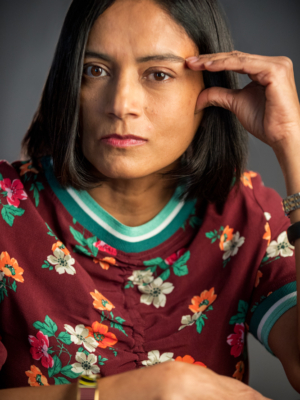The Many Uses of Safety Pins
Like many Indian women, my mother always kept safety pins dangling from her bangles or from the gold chain around her neck. When it became necessary, she would deftly unpin one from its perch and use it to temporarily mend tears in our clothing, substitute for a missing button, or thread a cord through the waistband of an underskirt or a pair of pajamas.
My mother was expert at wrapping her sari around herself and keeping it on—no part of it ever worked loose from her body even when she was asleep—but women who were less adept relied on safety pins to hold their saris in place at the shoulder or the pleats together at the waist.
The safety pins could be purchased almost anywhere, in sets of a dozen that ranged in size from an inch long to two inches long, the eleven smallest strung on the largest. Attached to a bunch was a tiny green label with the brand name printed on it. With use the pins often rusted despite (supposedly) being made of stainless steel, or became gnarled and twisted, although we could always bend them straight by laying them flat against a hard surface and pressing down. If a pin was so deformed that we could not jab it through our clothing, we threw it away. Later, delicate gold ones came on the market for uses that required pins with the slenderest of diameters, ones that did not initiate tears in the fabric. These invisible pins we used on our finest silks and airiest cottons.
When I began wearing Western clothing, I found new uses for safety pins. I would use one as a button where none existed. If the neck of a pretty blouse was too deep, I’d pinch the sides together and close it with a safety pin. A safety pin helped to bridge the gap between the second and third button of a collared shirt where the placket might gape open to reveal the swell of my bra. If an otherwise demure blouse came with side slits that rose too high above the hem, high enough to reveal inches of my midriff—the skin warm gold, barely touched by the sun—I would clap the slits shut with a pin, as I would the too-high openings in the front panels of some skirts.
When I moved to America, I continued to buy safety pins, hunting for them in the aisles at Walmart and CVS, where I would find them tossed on a bottom shelf along with relics from a vanishing age, such as talcum powder and face bleach, items that hadn’t changed in decades, that the stores would carry until all the members of a certain generation passed. I’d take my pins home and place them on the top shelf of my bathroom cabinet where I could find them easily, and make sure to pop a few in my toiletry case when I travelled.
It is not easy to use a safety pin for the purposes I detailed above. For the pin to remain invisible, I must pierce the tip through the layer of fabric next to my skin and carefully run its length through the space between the inner and outer layers. The operation is fraught with error and requires many attempts; it cannot be hurried. I must allow extra time to get dressed if a blouse or a skirt requires this safety measure.
As I grow older I have become careless about whether a pin shows. If it shows, if the pin glints silver, or the fabric wrinkles, looks wrong, tells a tale, I reason that the worst that will happen is that my desire for modesty is revealed to any observers, which should not hurt me. On the other hand, an exposed pin will reveal my belief: that there are people—men—out there who might be interested in looking at my body. I should be embarrassed if people knew this about me—that I think of myself as a thing to be looked at. The safety pin, the measure I take to protect my body, itself diminishes me.
Come summer, I go shopping and, where I live now, it is almost impossible to find a dress with a neckline that does not dip. A long dress surprises with a high front or side slit, a demure, high-necked dress plunges dizzyingly in the back or features bold cutouts. Where I live now, it is more unusual to be like me and seek clothing that hermitically seals the body, or to tweak clothing to so seal. In the way I dress, I stand in danger of revealing my discomfort with my own body.
The word “safety” is key. What I seem to want is for my cleavage, my thighs, my midriff to be locked away from eyes (of men). The belief behind my want: if I do not conceal it, my body will be devoured by eyes (of wolf-men).
* * *
I grew up in south India in an English-speaking, upper-middle-class family. Like most girls in urban areas, I wore frocks and skirts and blouses until I was about fifteen, after which I graduated to traditional Indian clothing. I did not wear Western clothing until I left for America, except for a brief interlude in my first year of college when I experimented with jeans and then again when I knew I was leaving.
Everyday wear for me was a salwar-kameez set or one of its variations. Ready-to-wear was not common when I was growing up; I’d instead buy lengths of fabric and get them sewn to my design by a tailor. I loved designing my clothes. I would add a bit of lace here, long sleeves there, play with the shape of the neckline, although I’d always make sure its plunge was small. A treasured outfit that I remember vividly: a long-sleeved kameez, or top, made of light brown polyester with pink lace at the wrists and neck, over a matching salwar, or pants. I would pair this outfit with bright pink bangles that tinkled as I typed computer code at my desk. With each outfit I would include a matching dupatta, or scarf, made of crisp cotton or fluid chiffon. I favored the traditional method of wearing the dupatta in a U shape across my chest, the method that covered my bust the most. I owned piles and piles of salwar-kameez sets, which I bequeathed to my sisters when I left.
“The word “safety” is key. What I seem to want is for my cleavage, my thighs, my midriff to be locked away from eyes (of men). The belief behind my want: if I do not conceal it, my body will be devoured by eyes (of wolf-men).”
Saris were for special occasions. I loved wearing saris. I would add dangling earrings and a nice hairdo and feel dressed up and special. I’d angle for compliments and feel like the belle of the ball even if all the girls were wearing saris.
I remember the first time I wore a sari, a blue silk, at my sister’s wedding. I was eighteen, a student of engineering. I wore no makeup. I was very thin—I weighed only eighty pounds in those days—and my chest would not have filled my blouse. I must have looked scrubbed and plain, overwhelmed by the heavy silk. Someone sent me on an errand up on the wedding stage. I scurried across it, self-conscious, sure that all eyes were on me. I probably forgot what I was sent to do. There is nothing quite like the flutter of a sari to make a girl forget to think. There is nothing quite like a dupatta to make her want to pull it tighter around herself.
For a while now I have been feeling differently toward these outfits, which are still the primary modes of dress for most Indian women. While they kept me busy covering myself up, time passed and passed and I reached an age at which I would do myself a favor if I hid my discolored knees, my veiny calves, my unbeautiful belly. I have never worn spaghetti straps and tank tops and now never will. I have never worn a bikini and never will.
* * *
A salwar-kameez, as you may have inferred, consists of three distinct pieces, a knee-length kameez, a billowing salwar, and a dupatta. While the kameez flows loosely below the waist, it is usually close-fitting at the bust and sometimes features a low neckline.
In its most common avatar, the sari also consists of three pieces: a blouse, a long underskirt, and a length of fabric that the wearer tucks into the underskirt, wraps twice around her lower half (making pleats on the second lap), then throws across her shoulder (covering her chest along the way) in an end piece called the pallu.
There are many variations of the typical format of these outfits, but all of them cover the legs completely. Which means that most Indian girls and women go through their lives with their legs concealed. That we have legs is kept so secret that the sight of a length of a woman’s leg, exposed accidentally while she is napping or getting out of a car, is arresting, an alien sighting, a pale, speckled log, vaguely diseased.
On an Indian TV news show recently, I saw rows and rows of middle-aged Indian women, seated, listening to a speaker, all of them wearing saris, the broad panes of their pallus girded tightly across their chests. Their hair was oiled and bunned, and they looked serious, each the picture of the dignified Indian sari-clad woman, no skin showing except from neck up, elbows to tips of fingers, and in the modest U of their blouses in the back.
A sari, however, can be anything but dignified. A sari is ambiguity in the form of fabric. Neither as assertive as Western clothing nor as opaque as a burkha, a sari is invitation and rebuff, provocation and decorum. In contrast to the manner in which a sari enshrouds the wearer’s lower half, its blouse, fitted and often low-cut, is made for sculpting cleavage, as is the bodice of a salwar-kameez. With a drop of the pallu—and pallus often drop in Indian movies—a sari metamorphoses into the most seductive outfit imaginable, even with a demure blouse.
My imagination runs away with me: perhaps a pallu exists for the excitement it produces when it is off, a dupatta for the excitement it produces when it is off? The pallu and the dupatta thus have the potential to make unwitting coquettes of wearers by drawing attention to what they conceal. Once, when I was in my twenties and staying in a training facility dormitory in New Delhi, I received an anonymous phone call from a man who informed me, in a low, throbbing voice, that I looked “fine without dupatta.” Perhaps a gust of wind had blown off my dupatta for seconds? There is a deep irony in the occurrence of an indignity such as this to women who go around covered from neck to ankle.
At any rate I pulled my scarf even more securely around me, that day and always. I hugged my inhibitions to myself and made a high virtue of modesty.
* * *
I began wearing Western clothing the year before I moved to America, beginning with baggy jeans and long skirts and loose “bum-covering” tops that I constantly, anxiously, pulled even lower, much like I constantly, anxiously, arranged my dupatta around myself. It was only in my thirties that my knees emerged in public, shyly, like fawns from a thicket. Now I do wear dresses that end above the knees but only in the Western world. I will not reveal my legs when I am in India; I’ll sweat through the trip in jeans instead. Even in America I will not reveal my legs when conservative Indian men who have grown up in India are present or, for that matter, conservative Indian women. I will not wear a one-piece bathing suit in front of almost any Indian man. I own piles of scarves and will often wind one around my neck and let the ends hover protectively about my chest.
In the sea of skin I find myself in, in the respectable, respectful circles I move in, whose eyes do I think are going to devour me, a middle-aged woman with teenaged children and incipient cheek jowls?
In a spin cycling class in Newton, Massachusetts, that I attended recently, I was struck by how little the girls wore: bra tops that were mere pinstripes across their backs and triangles in the front paired with shorts that began below their navels and ended inches later or leggings made of fabric so thin they looked like ripples of neon paint. Girls in spin classes wear even less than girls in gyms, perhaps because they expect to sweat. I was the only woman wearing a sleeved top; a few men kept me company. I stared (creepily) at the girls’ bodies, the curve of their shoulders, their bellies, made concave as they bent over their bikes. I could not believe how beautiful they were. I was moved to tears that there is a place in the world where girls can be so free.
Say what you will, a young body is more beautiful than an old one. I had a belly like theirs once, I thought, as flat as a plank, as ordained by nature. I had firm upper arms and unmarked knees and skin as smooth as butter. But I have no memories of myself looking even remotely like those girls. I did not comprehend my own perfection. I did not flaunt it. I did not treat it with the reverence I should have treated something so fleeting. I did not dress it and make it its best. I wasted it and then time stole it.
With my young daughter I now navigate an unfamiliar world of tiny garments that fold down to nothing, or are all strings and therefore impossible to fold. I research and procure for her all manner of bras and stickies and fixes that enable her to wear backless dresses, low-cut dresses, mini-skirts, bikinis. I have the opposite of conversations that I imagine most mothers have with their daughters. I tell her she must wear these things now because if she does not now, she will have a hard time doing so later. I tell her to dress with good sense, not with inhibitions. I do not say these words exactly—she is only thirteen—but what I want is for her to be no more conscious if her neckline happens to dip than if her sleeve rides up. What I want is for her to not think of her body as a liability.
Anu Kandikuppa’s short stories have appeared or will appear in CALYX, Epiphany, Salt Hill, The Florida Review, The Normal School, and other journals. Her work has been nominated for a Pushcart Prize (twice) and for the Best of the Net Anthology. She holds an MFA from the Program for Writers at Warren Wilson College. Anu lives in Boston and worked as an economic consultant in a former life.





